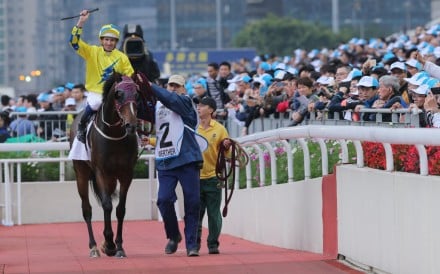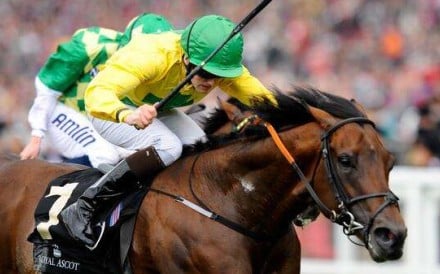Sunday sees Hong Kong step up to the plate in Singapore in an attempt to repeat last year’s domination of their two feature races, the Singapore Airlines International Cup and the KrisFlyer Sprint.
Hong Kong is represented by last year’s 1-2 Military Attack and Dan Excel in the Cup, while Lucky Nine looks to go back-to-back in the Sprint but faces stiff opposition from Golden Shaheen winner Sterling City.
It is refreshing to see horses as gypsies of sorts, having come from a background where horses stay at home for a number of reasons: fear of failure is one, as well as the insular belief that Australian racing is superior to any other product around the world. Totally deluded, of course.
Hong Kong was represented in record numbers in Dubai this year. Obviously, we’re back in Singapore, while it’s possible we’ll have a couple of runners in next month’s Yasuda Kinen in Japan. We’d probably be donning our top hats for Royal Ascot too, if not for Ricky Yiu Poon-fai’s preference for a flat track for Amber Sky.
And with Akeed Mofeed potentially travelling to the United States for the Arlington Million and a couple of potential spring raiders to Melbourne, there will be plenty of chances to hear March of the Volunteers.
Since the days of Hong Kong’s first globetrotter, David Hill-trained and Ronald Arculli-owned River Verdon (who finished 11th in the 1992 Arlington Million, 11th in the 1994 Cox Plate and 20th in the 1994 Melbourne Cup), horses have continued to head overseas in an attempt to plunder some of the world’s great races. And in the past decade or so, success has continued to grow.

But it is not just a desire for international success that sees horses travel abroad regularly. The main reason is there are simply not enough races in Hong Kong for the cream of the crop.
It’s one of the quirks – read benefits – of the Hong Kong system that there are so few races for top-class gallopers, as it means the best horses either take on each other regularly – there is no hiding and it makes for competitive racing – or it forces them to look beyond Sha Tin.
There are only 15 Group One races, with six open to global competition; seven Group Two races, with three open to internationals; and 12 Group Three races. And with the spread of distances taken into account, there are very few races to pick and choose from for highly rated gallopers.
It is among the sprinters where this is most stark, especially when comparing with a jurisdiction like Australia. If you have a horse who excels at 1,200m but is rated 124 (Lucky Nine) or 123 (Sterling City), you are limited in the races you can target.
Indeed, after the Chairman’s Sprint Prize in mid-February, which Lucky Nine won this year with Sterling City an unlucky fourth, there is little left here until October.
Lucky Nine took one route, to the Group One Queen’s Silver Jubilee Cup (1,400m) before coming back in trip for the Group Two Sprint Cup. A defence of his Singapore title was always on the cards.
The other local route is to stick around for races like next week’s Sha Tin Vase, which is a Group Three handicap. If Lucky Nine had stayed for that race last year, for example, he would have had to carry 133 pounds, conceding a lot of weight to the likes of Charles The Great, Rich Tapestry, Go Baby Go, Time After Time and Frederick Engels.
Sterling City took the other option –- go to Dubai for the Golden Shaheen. It would now be mad for him to stick here, as his connections are in line for a US$1 million Global Sprint Challenge bonus if he can win two of the remaining seven legs, of which the KrisFlyer is one. It also means he is likely to find himself in Melbourne in the spring, before returning for the Longines Hong Kong Sprint.

For both horses, Singapore was – and is – the best end-of-season target. And if it weren’t for logistical obstacles – a lack of staff, effectively – a horse like Charles The Great would have made the trip, too.
It is a far cry from Australia, where there were two Group One races at 1,200m last Saturday. Sure, they were a tick over 1,600 kilometres apart – the same distance as between Hong Kong and Bangkok – but still, what incentive is there to travel when they have two Group One races to choose from on the same day? And where is the prestige in Group One racing when they are handed out so easily?
Brisbane’s 1,200m Group One, the BTC Cup at weight-for-age, featured just seven runners but was the better of the two races, with The Goodwood at Morphettville in Adelaide containing a long tail and looking more like a glorified Group Two.
The races also represented the eighth and ninth opportunity to win an open Group One over 1,200m in the Australian season, following the Moir Stakes, Manikato Stakes, VRC Sprint Classic, Winterbottom Stakes, Newmarket Handicap, William Reid Stakes and T J Smith Stakes.
Give me Hong Kong’s minimal approach any day. At least it means Sunday’s races are of interest to local punters.





















